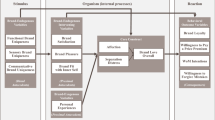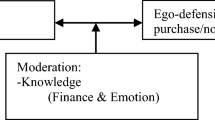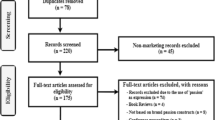Abstract
Brand user imagery is an important aspect of brand association and, consequently, brand equity. Extant conceptualizations emphasize content features of brand user imagery (e.g., convergence and favorability) but neglect the structural element of the concept, namely the clarity of the imagery. The purpose of this paper is to present the concept of brand user imagery clarity (BUIC) as a distinct and salient aspect of brand user imagery. Drawing on the associate network theory of memory, we offer a conceptualization of BUIC and then proceed to empirically validate a BUIC scale using data from 1172 consumers across four surveys and multiple industries. Results demonstrate the reliability of our 5-item BUIC scale. The scale consistently demonstrates convergent validity and discriminant validity (in relation to brand user imagery favorability, brand prestige, brand quality, and brand personality). Assessment of nomological validity identifies premium pricing strategy as a key determinant of BUIC and self-brand connection as an important outcome. This study contributes to branding literature by proposing BUIC as an important structural feature of brand user imagery and developing a reliable BUIC scale. It also contributes to the consumer–brand relationship literature by indicating the significant effect of BUIC on self-brand connection.

Similar content being viewed by others
References
Aagerup, U. 2010. To sell or not to sell: Overweight users’ effect on fashion assortments. Journal of Brand Management 18(1): 66–78.
Aaker, D.A. 1996. Measuring brand equity across products and markets. California Management Review 38(3): 102–120.
Aaker, J.L. 1997. Dimensions of brand personality. Journal of Marketing Research 34(3): 347–356.
Aaker, J.L., V. Benet-Martínez, and J. Garolera. 2001. Consumption symbols as carriers of culture: A study of Japanese and Spanish brand personality constructs. Journal of Personality and Social Psychology 81(3): 492–508.
Aaker, J.L., S. Fournier, and S.A. Brasel. 2004. When good brands do bad. Journal of Consumer Research 31(1): 1–16.
Aaker, D.A., and E. Joachimsthaler. 1999. The lure of global branding. Harvard Business Review 77(6): 137–144.
Alden, D.L., J.-B.E.M. Steenkamp, and R. Batra. 1999. Brand positioning through advertising in Asia, North America, and Europe: The role of global consumer culture. Journal of Marketing 63(1): 75–87.
Amaldoss, W., and S. Jain. 2005. Conspicuous consumption and sophisticated thinking. Management Science 51(10): 1449–1466.
Anderson, J.C., and D.W. Gerbing. 1988. Structural equation modeling in practice: A review of recommended two-step approach. Psychological Bulletin 103(3): 411–423.
Baek, T.H., J. Kim, and J.H. Yu. 2010. The differential roles of brand credibility and brand prestige in consumer brand choice. Psychology & Marketing 27(7): 662–678.
Bagozzi, R.P., and Y. Yi. 1988. On the evaluation of structural equation models. Journal of Academy of Marketing Science 16(1): 74–94.
Bagozzi, R.P., Y. Yi, and L.W. Phillips. 1991. Assessing construct validity in organizational research. Administrative Science Quarterly 36(3): 421–458.
Batra, R., A. Ahuvia, and R.P. Bagozzi. 2012. Brand love. Journal of Marketing 76(2): 1–16.
Bearden, W.O., R.G. Netemeyer, and M.F. Mobley. 1993. Handbook of marketing scales: Multi-item measures for marketing and consumer behavior research. Newbury Park, CA: Sage Publications.
Belk, R.W. 1988. Possessions and the extended self. Journal of Consumer Research 15(2): 139–168.
Bishnoi, V.K., and A. Kumar. 2016. Aaker’s brand personality scale is not universal—Explanation and reasons for bikes in India. Journal of Marketing Analytics 4(1): 14–27.
Bridges, S., K.L. Keller, and S. Sood. 2000. Communication strategies for brand extensions: Enhancing perceived fit by establishing explanatory links. Journal of Advertising 29(4): 1–11.
Busch, P., and R.F. Bush. 1978. Women contrasted to men in the industrial salesforce: Job satisfaction, values, role clarity, performance, and propensity to leave. Journal of Marketing Research 15(3): 438–448.
Campbell, D.T. 1960. Recommendations for APA test standards regarding construct, trait, or discriminant validity. American Psychologist 15(8): 546–553.
Campbell, J.D. 1990. Self-esteem and clarity of the self-concept. Journal of Personality and Social Psychology 59(3): 538–549.
Campbell, J.D., P.D. Trapnell, S.J. Heine, I.M. Katz, L.F. Lavallee, and D.R. Lehman. 1996. Self-concept clarity: Measurement, personality correlates, and cultural boundaries. Journal of Personality and Social Psychology 70(1): 141–156.
Cardador, M.T., and M.G. Pratt. 2006. Identification management and its bases: Bridging management and marketing perspectives through a focus on affiliation dimensions. Journal of the Academy of Marketing Science 34(2): 174–184.
Chattopadhyay, P., E. George, and S.A. Lawrence. 2004. Why does dissimilarity matter? Exploring self-categorization, self-enhancement, and uncertainty reduction. Journal of Applied Psychology 89(5): 892–900.
China Daily. 2014. 8 luxury cars and the image of their owners. 1 December. http://usa.chinadaily.com.cn/china/2014-12/01/content_19004494_2.htm.
Churchill Jr., G.A. 1979. A paradigm for developing better measures of marketing constructs. Journal of Marketing Research 16(1): 64–73.
Davari, A., and D. Strutton. 2014. Marketing mix strategies for closing the gap between green consumers’ pro-environmental beliefs and behaviors. Journal of Strategic Marketing 22(7): 563–586.
DeVellis, R.F. 2003. Scale development: Theory and application. 2nd ed. Newbury Park, CA: Sage Publications.
Devine, P.G. 1989. Stereotypes and prejudice: Their automatic and controlled components. Journal of Personality and Social Psychology 56(1): 5–18.
Escalas, J.E. 2004. Narrative processing: Building consumer connections to brands. Journal of Consumer Psychology 14(1/2): 168–179.
Escalas, J.E., and J.R. Bettman. 2003. You are what they eat: The influence of reference groups on consumers’ connections to brands. Journal of Consumer Psychology 13(3): 339–348.
Escalas, J.E., and J.R. Bettman. 2005. Self-construal, reference groups, and brand meaning. Journal of Consumer Research 32(3): 378–389.
Ferraro, R., A. Kirmani, and T. Matherly. 2013. Look at me! look at me! conspicuous brand usage, self-brand connection, and dilution. Journal of Marketing Research 50(4): 477–488.
Fiske, S.T., and S.E. Taylor. 1991. Social cognition. 2nd ed. New York: McGraw-Hill.
Ford, K. 2009. Mac versus PC people: Personality traits and aesthetic/media choices. http://hunch.com/media/reports/macpc/Mac_PC_report_11_24.pdf. Accessed 2 June 2010.
Forehand, M.R., A. Perkins, and A. Reed. 2011. When are automatic social comparisons not automatic? The effect of cognitive systems on user imagery-based self-concept activation. Journal of Consumer Psychology 21(1): 88–100.
Fornell, C., and D.F. Larcker. 1981. Evaluating structural equation models with unobservable variables and measurement error. Journal of Marketing Research 18(1): 39–50.
Fournier, S. 1998. Consumers and their brands: Developing relationship theory in consumer research. Journal of Consumer Research 24(4): 343–353.
Fuchs, C., and A. Diamantopoulos. 2010. Evaluating the effectiveness of brand-positioning strategies from a consumer perspective. European Journal of Marketing 44(11/12): 1763–1786.
Gerbing, D.W., and J.C. Anderson. 1988. An updated paradigm for scale development incorporating unidimensionality and its assessment. Journal of Marketing Research 25(2): 186–192.
Granitz, N., and H. Forman. 2015. Building self-brand connections: Exploring brand stories through a transmedia perspective. Journal of Brand Management 22(1): 38–59.
Grohmann, B. 2009. Gender dimensions of brand personality. Journal of Marketing Research 46(1): 105–119.
Groth, J.C. 1994. The exclusive value principle—A concept for marketing. Journal of Product & Brand Management. 3(3): 8–18.
Gutsatz, M., and K. Heine. 2018. Is luxury expensive? Journal of Brand Management 25(5): 411–423.
Han, Y.J., J.C. Nunes, and X. Drèze. 2010. Signaling status with luxury goods: The role of brand prominence. Journal of Marketing 74(4): 15–30.
Hardesty, D.M., and W.O. Bearden. 2004. The use of expert judges in scale development: Implications for improving face validity of measures of unobservable constructs. Journal of Business Research 57(2): 98–107.
He, H., and X. Zhou. 2019. China’s white-collar workers earned less in first quarter of 2019 despite signs of economic recovery, survey finds. South China Morning Post. https://www.scmp.com/economy/china-economy/article/3008273/chinas-white-collar-workers-earned-less-first-quarter-2019. Accessed 30 Apr 2019.
Hogg, M.A., D.J. Terry, and K.M. White. 1995. A tale of two theories: A critical comparison of identity theory with social identity theory. Social Psychology Quarterly 58(4): 255–269.
Huber, F., F. Meyer, J. Vogel, A. Weihrauch, and J. Hamprecht. 2013. Endorser age and stereotypes: Consequences on brand age. Journal of Business Research 66(2): 207–215.
Joachimstahler, E., and D.A. Aaker. 1997. Building brands without mass-media. Harvard Business Review 75(1): 41–50.
Keane, M.P., and B. Sun. 2008. A dynamic model of brand choice when price and advertising signal product quality. Marketing Science 27(6): 1111–1125.
Keller, K.L. 1993. Conceptualizing, measuring, and managing customer-based brand equity. Journal of Marketing 57(1): 1–22.
Keller, K.L. 2003. Brand synthesis: The multidimensionality of brand knowledge. Journal of Consumer Research 29(4): 595–600.
Keller, K.L. 2016. Reflections on customer-based brand equity: Perspectives, progress, and priorities. AMS Review 6(1–2): 1–16.
Keller, K.L., and K. Richey. 2006. The importance of corporate brand personality traits to a successful twenty-first century business. Journal of Brand Management 14(1–2): 74–81.
Lichtenstein, D.R., N.M. Ridgway, and R.G. Netemeyer. 1993. Price perceptions and consumer shopping behavior: A field study. Journal of Marketing Research 30(2): 234–245.
Liu, F., J. Li, D. Mizerski, and H. Soh. 2012. Self-congruity, brand attitude, and brand loyalty: A study on luxury brands. European Journal of Marketing 46(7/8): 922–937.
Mael, F., and B.E. Ashforth. 1992. Alumni and their alma mater: A partial test of the reformulated model of organizational identification. Journal of Organizational Behavior 13(2): 103–123.
Marín, L., and R.D.M. Salvador. 2013. The role of affiliation, attractiveness and personal connection in consumer–company identification. European Journal of Marketing 47(3/4): 655–673.
McCracken, G. 1986. Culture and consumption: A theoretical account of the structure and movement of the cultural meaning of consumer goods. Journal of Consumer Research 13(1): 71–84.
McCracken, G. 1989. Who is the celebrity endorser? Cultural foundations of the endorsement process. Journal of Consumer Research 16(3): 310–321.
Mittal, B. 2015. Self-concept clarity: Exploring its role in consumer behavior. Journal of Economic Psychology 46(1): 98–110.
Moreau, C.P., L. Bonney, and K.B. Herd. 2011. It’s the thought (and the effort) that counts: How customizing for others differs from customizing for oneself. Journal of Marketing 75(5): 120–133.
Muniz Jr., A.M., and T.C. O’Guinn. 2001. Brand community. Journal of Consumer Research 27(4): 412–432.
Nunnally, J.C. 1978. Psychometric theory. 2nd ed. New York: McGraw-Hill.
O’Cass, A., and H. Frost. 2002. Status brands: Examining the effects of non-product-related brand associations on status and conspicuous consumption. Journal of Product & Brand Management 11(2): 67–88.
Parasuraman, A., V.A. Zeithaml, and L.L. Berry. 1988. SERVQUAL: A multiple-item scale for measuring consumer perceptions of service quality. Journal of Retailing 64(1): 12–40.
Park, J.K., and D.R. John. 2018. Judging a book by its cover: The influence of implicit self-theories on brand user perceptions. Journal of Consumer Psychology 28(1): 56–76.
Park, C.W., D.J. MacInnis, J. Priester, A.B. Eisingerich, and D. Iacobucci. 2010. Brand attachment and brand attitude strength: Conceptual and empirical differentiation of two critical brand equity drivers. Journal of Marketing 74(6): 1–17.
Parker, B.T. 2009. A comparison of brand personality and brand user-imagery congruence. Journal of Consumer Marketing 26(3): 175–184.
Podsakoff, P.M., S.B. MacKenzie, J.-Y. Lee, and N.P. Podsakoff. 2003. Common method biases in behavioral research: A critical review of the literature and recommended remedies. Journal of Applied Psychology 88(5): 879–903.
Radler, M.V. 2018. 20 years of brand personality: A bibliometric review and research agenda. Journal of Brand Management 25(4): 370–383.
Rao, A.R., and R.K.B. Monroe. 1989. The effect of price, brand name, and store name on buyers’ perceptions of product quality: An integrative review. Journal of Marketing Research 26(3): 351–357.
Steenkamp, J.B.E.M., R. Batra, and D.L. Alden. 2003. How perceived brand globalness creates brand value. Journal of International Business Studies 34(1): 53–65.
Tian, K.T., W.O. Bearden, and G.L. Hunter. 2001. Consumers’ need for uniqueness scale development and validation. Journal of Consumer Research 28(1): 50–66.
Tuškej, U., and K. Podnar. 2018. Consumers’ identification with corporate brands: Brand prestige, anthropomorphism and engagement in social media. Journal of Product & Brand Management 27(1): 3–17.
Van de Vijver, F., and K. Leung. 1997. Methods and data analysis for cross-cultural research. Thousand Oaks, CA: Sage Publications.
van Veelen, R., S. Otten, and N. Hansen. 2013. Social identification when an in-group identity is unclear: The role of self-anchoring and self-stereotyping. British Journal of Social Psychology 53(2): 543–562.
Vera, J. 2015. Perceived brand quality as a way to superior customer perceived value crossing by moderating effects. Journal of Product & Brand Management 24(2): 147–156.
Voss, K.E., E.R. Spangenberg, and B. Grohmann. 2003. Measuring the hedonic and utilitarian dimensions of consumer attitude. Journal of Marketing Research 40(3): 310–320.
Wyer, R.S., and D.E. Carlston. 1994. The cognitive representation of persons and events. In Handbook of social cognition. 2nd ed, ed. R.S. Wyer and T.K. Srull, 41–98. Hillsdale, NJ: Lawrence Erlbaum Associates.
Yoo, B., N. Donthu, and S. Lee. 2000. An examination of selected marketing mix elements and brand equity. Journal of the Academy of Marketing Science 28(2): 195–211.
Zaichkowsky, J.L. 1985. Measuring the involvement construct. Journal of Consumer Research 12(3): 341–352.
Acknowledgements
This work was supported by the National Natural Science Foundation of China (Nos. 71972038, 71632001, 71832015), by the Fundamental Research Funds for the Central Universities in UIBE (CXTD9-03) and by the Program for Excellent Talents, UIBE (No. 17YQ20).
Author information
Authors and Affiliations
Corresponding author
Ethics declarations
Conflict of interest
On behalf of all authors, the corresponding author states that there is no conflict of interest.
Additional information
Publisher's Note
Springer Nature remains neutral with regard to jurisdictional claims in published maps and institutional affiliations.
Appendix
Appendix
The initial item pool for BUIC scale
1. |
I feel certain that I know the main features of the brand’s typical users |
2. |
It is easy for me to describe what the brand’s typical users are like |
3. |
I have to spend little time thinking before I can describe what the typical users of the brand are like |
4. |
When I think about typical users of this brand, I’m sure what they are really like |
5. |
I have a clear sense of the main features of the brand’s typical users |
6. |
On 1 day I might have one opinion of the brand’s typical users and on another day I might have a different opinion (r) |
7. |
I can tell what kinds of products/services the brand’s typical users may like |
8. |
Sometimes I feel that the brand’s typical users are not really the persons that I believed are (r) |
9. |
I am certain that the associations I have about the brand’s typical users really reflect what they truly are |
10. |
I seldom find conflict between the different aspects of the brand’s typical users in my minds |
11. |
My beliefs about the brand’s typical users seem to change very frequently (r) |
12. |
I am not able to describe the brand’s typical users clearly (r) |
13. |
It is not difficult for me to describe what the brand’s typical users are like |
14. |
My beliefs about the brand’s typical users conflict with one another (r) |
15. |
I know exactly what the brand’s typical users are like |
16. |
I think I know other brands’ typical users better than I know this brand’s typical users (r) |
17. |
Even if I wanted to, I do not think I would tell someone what the brand’s typical users really like (r) |
18. |
To what extent are you clear about the values of the brand’s typical users? |
19. |
To what extent are you clear about the product preferences of the brand’s typical users? |
20. |
To what extent are you clear about the goals that the brand’s typical users hold? |
21. |
To what extent are you clear about the education background of the brand’s typical users? |
22. |
To what extent are you clear about the economic status of the brand’s typical users? |
23. |
To what extent are you clear about the personality of the brand’s typical users? |
24. |
To what extent are you clear about the social status of the brand’s typical users? |
25. |
To what extent are you clear about the lifestyle of the brand’s typical users? |
26. |
To what extent are you clear about the consumption patterns of the brand’s typical users? |
27. |
How clear are you about the brand’s typical users? |
28. |
I am confident that my knowledge about the brand’s typical users is accurate |
29. |
To what extent are your beliefs about the brand’s typical users vague? (r) |
Rights and permissions
About this article
Cite this article
Xie, Y., Peng, S. & Hampson, D.P. Brand user imagery clarity (BUIC): conceptualization, measurement, and consequences. J Brand Manag 27, 662–678 (2020). https://doi.org/10.1057/s41262-020-00202-w
Revised:
Published:
Issue Date:
DOI: https://doi.org/10.1057/s41262-020-00202-w




